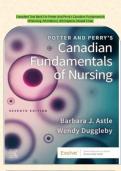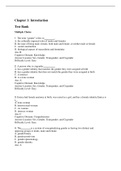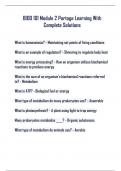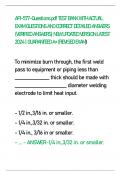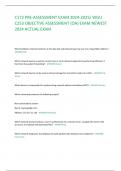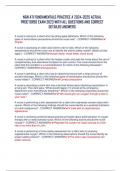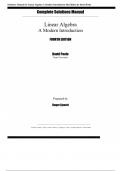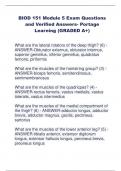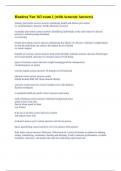Complete Test Bank For Potter And Perry's Canadian Fundamentals
Of Nursing 7th Edition| All Chapters |Rated 5 Star
,Table Of Contents
Chapter 01: Health And Wellness ........................................................................................................... 3
Chapter 02: The Canadian Health Care Delivery System ...................................................................... 14
Chapter 03: The Development Of Nursing In Canada........................................................................... 23
Chapter 04: Community Health Nursing Practice ................................................................................. 31
Chapter 05: Theoretical Foundations Of Nursing Practice ................................................................... 41
Chapter 06: Evidence-Informed Practice .............................................................................................. 48
Chapter 07: Nursing Values And Ethics................................................................................................. 58
Chapter 08: Legal Implications In Nursing Practice .............................................................................. 67
Chapter 09: Global Health..................................................................................................................... 79
Chapter 10: Indigenous Health ............................................................................................................. 89
Chapter 11: Nursing Leadership, Management, And Collaborative Practice ....................................... 99
Chapter 12: Critical Thinking In Nursing Practice................................................................................ 108
Chapter 13: Nursing Assessment, Diagnosis, And Planning................................................................ 118
Chapter 14: Implementing And Evaluating Nursing Care ................................................................... 132
Chapter 15: Documenting And Reporting........................................................................................... 145
Chapter 16: Nursing Informatics And Canadian Nursing Practice ...................................................... 162
Chapter 17: Communication And Relational Practice ........................................................................ 170
Chapter 18: Patient-Centred Care: Interprofessional Collaborative Practice..................................... 185
Chapter 19: Family Nursing................................................................................................................. 194
Chapter 20: Patient Education ............................................................................................................ 203
Chapter 21: Developmental Theories ................................................................................................. 217
Chapter 22: Conception Through Adolescence .................................................................................. 228
Chapter 23: Young To Middle Adulthood ........................................................................................... 240
Chapter 24: Older Persons .................................................................................................................. 251
Chapter 25: The Experience Of Loss, Death, And Grief ...................................................................... 264
Chapter 26: Self-Concept .................................................................................................................... 275
Chapter 27: Sexuality .......................................................................................................................... 285
Chapter 28: Spirituality In Health And Health Care ............................................................................ 296
Chapter 29: Stress And Adaptation..................................................................................................... 306
Chapter 30: Vital Signs ........................................................................................................................ 316
Chapter 31: Pain Assessment And Management................................................................................ 338
Chapter 32: Health Assessment And Physical Examination................................................................ 357
Chapter 33: Infection Control ............................................................................................................. 375
Chapter 34: Medication Administration ............................................................................................. 397
Chapter 35: Complementary And Alternative Approaches In Health Care ........................................ 416
,Chapter 36: Activity And Exercise ....................................................................................................... 426
Chapter 37: Quality And Patient Safety .............................................................................................. 441
Chapter 38: Hygiene ........................................................................................................................... 456
Chapter 39: Cardiopulmonary Functioning And Oxygenation ............................................................ 479
Chapter 40: Fluid, Electrolyte, And Acid–Base Balances .................................................................... 499
Chapter 41: Sleep ................................................................................................................................ 520
Chapter 42: Nutrition .......................................................................................................................... 529
Chapter 43: Urinary Elimination ......................................................................................................... 549
Chapter 44: Bowel Elimination ........................................................................................................... 569
Chapter 45: Mobility And Immobility ................................................................................................. 585
Chapter 46: Skin Integrity And Wound Care ....................................................................................... 607
Chapter 47: Sensory Alterations ......................................................................................................... 632
Chapter 48: Care Of Surgical Patients ................................................................................................. 645
Chapter 01: Health And Wellness
Potter Et Al: Canadian Fundamentals Of Nursing, 7th Edition
MULTIPLE CHOICE
1. The Nurse Is Using The Population Health Promotion Model To Develop Actions For
Improving Health. After Asking, “On What Should We Take Action?”; “How Should We Take
Action?”; And “Why Should We Take Action?” The Nurse Will Ask Which Of The Following
Questions?
A. “With Whom Should We Act?”
B. “When Should We Take Action?”
C. “Which Government Should Take Action?”
D. “Where Should We First Act?”
CORRECT ANS>>A
The Next Question To Ask When Using The Population Health Model Approach Is “With Whom
Should We Act?” The Other Choices Are Not Questions Included In This Model.
DIF: Apply REF: 13 (Figure 1-5)
, OBJ: Contrast Distinguishing Features Of Health Promotion And Disease Prevention.
TOP: Implementation MSC: NCLEX: Health Promotion And Maintenance
2. The Principle “Health Promotion Is Multisectoral” Means Which Of The Following?
A. Relationships Between Individual, Social, And Environmental Factors Must Be Recognized.
B. Physical, Mental, Social, Ecological, Cultural, And Spiritual Aspects Of Health Must Be
Recognized.
C. In Order To Change Unhealthy Living And Working Conditions, Areas Other Than Health
Must Also Be Involved.
D. Health Promotion Uses Knowledge From Disciplines Such As Social, Economic, Political,
Environmental, Medical, And Nursing Sciences, As Well As From First-Hand Experience.
CORRECT ANS>>C
The Statement “Health Promotion Is Multisectoral” Is The Principle Explained By The Necessity To
Involve Areas Other Than Health In Order To Change Unhealthy Living And Working Conditions.
DIF: Understand REF: 11
OBJ: Contrast Distinguishing Features Of Health Promotion And Disease Prevention. TOP: Planning
MSC: NCLEX: Health Promotion And Maintenance
3. According To The World Health Organization, What Is The Best Description Of “Health”?
A. Simply The Absence Of Disease.
B. Involving The Total Person And Environment.
C. Strictly Personal In Nature.
D. Status Of Pathological State.
CORRECT ANS>>B
WHO Defines Health As “. . .The Extent To Which An Individual Or Group Is Able, On The One Hand,
To Realize Aspirations And Satisfy Needs; And, On The Other Hand, To Change Or Cope With The
Environment. Health Is, Therefore, Seen As A Resource For Everyday Life, Not The Objective Of
Living; It Is A Positive Concept Emphasizing Social And Personal Resources, As Well As Physical
Capacities.” Nurses’ Attitudes Toward Health And Illness Should Consider The Total Person, As Well
As The Environment In Which The Person Lives. People Free Of Disease Are Not Equally Healthy.
Views Of Health Have Broadened To Include Mental, Social, And Spiritual Well-Being, As Well As A
Focus On Health At Family And Community Levels.
Conditions Of Life, Rather Than Pathological States, Are What Determine Health.

